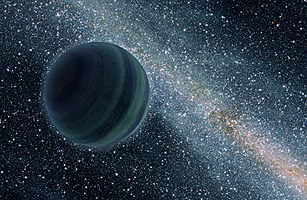
The bitterly fought Pluto wars of a few years back showed that even the experts disagree on what is and what isn’t a planet. One thing there’s no quarrel about, of course: a planet is, by definition, something that orbits a star.
Except, it turns out, when it isn’t. Writing in the latest issue of Nature, a team of astronomers is reporting the discovery of ten objects roughly the size of Jupiter that seem to be on the loose, roaming the galaxy untethered to any star. And while ten seems like an insignificant number in a galaxy packed with 200 billion or more stars, the search was an extremely limited one. Unless the observers happened to be absurdly lucky, there could actually be a lot more of these rogue Jupiters — perhaps twice as many stars as there are in the Milky Way. See the top 50 space moments since Sputnik.”The implications of this discovery,” writes Joachim Wambsganss, of the Center for Astronomy at the University of Heidelberg in an accompanying Nature commentary, “are profound.”
They aren’t, however, completely unexpected. As the known number of more conventional exoplanets — that is, those that actually do orbit stars — has grown to more than 500 in recent years, astronomers have begun to realize that our own well-behaved Solar System isn’t necessarily typical. The eight planets orbit the Sun in nearly circular orbits, all moving in the same direction as the Sun rotates. But plenty of alien worlds orbit their stars in eccentric, somewhat egg-shaped orbits and surprising numbers move around their stars in highly tilted orbits as well. Some planets even orbit backwards. See pictures of Saturn. That suggests that sometime in the past, close gravitational encounters with other planets flung them out of their previously conventional orbits. Theorists have predicted for years that such close encounters might also fling planets out into interstellar space.
“There’s nothing physically mysterious about this,” says David Stevenson, a Caltech astronomer who has been working on rogue-planet scenarios for more than a decade. “It’s a perfectly natural outcome.” See pictures of five nations’ space programs.Still, he says, it’s exciting to see something that had been purely theoretical backed up by hard evidence. It’s also notable that these planets were discovered with a technique that sounds like something out of Star Trek. As Einstein explained nearly a century ago, the gravity of a massive object such as a star or a planet warps the spacetime that surrounds it. If a ray of light passes close by, the light will be diverted, just as though it were passing through a giant lens. In the 1930’s, Einstein realized that if one star passed in front of another, the closer star could act as a “gravitational lens,” focusing the light of the more distant star and making it look brighter. We’d never actually see such an effect, conceded Einstein. All stars orbit the center of the galaxy at slightly different speeds, meaning that they are in constant motion relative to one another; still, the exact lineup needed to make true lensing occur would happen only very rarely, Einstein believed.
For once, though, the great man was wrong. The first gravitational lens was spotted in 1979 and they’ve become a mainstay of astronomical research ever since. This has aided in the search for exoplanets, as astronomers scan the skies for double flashes — one caused by a foreground star moving in front of a background star, and one following soon after, caused by the orbiting planet.